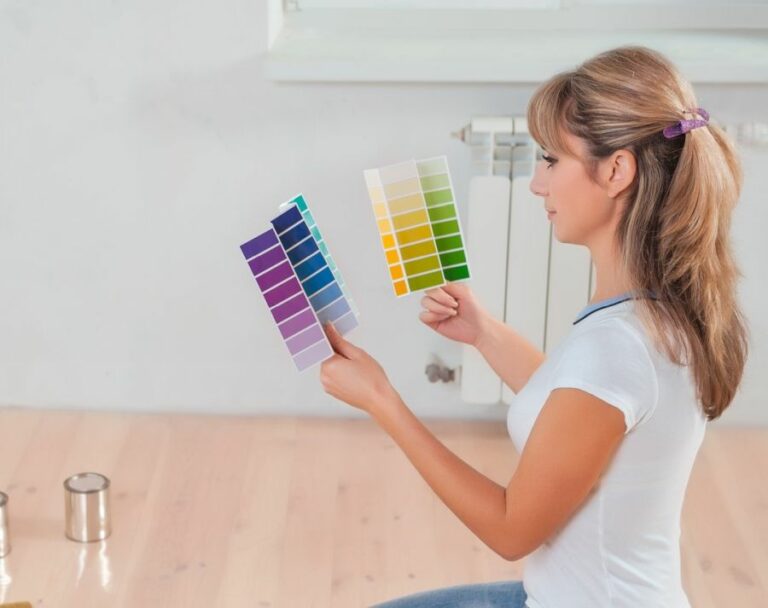Eco-Conscious Paint Options For Home. What Pros Say
Are you a homeowner looking to give your living space a new look while staying environmentally friendly? As people become more eco-conscious, the demand for sustainable and eco-friendly paint options rises. Lucky for you, we’ve done the research and can confidently guide you toward the best choices to revamp your home’s interior while positively impacting the environment.
Eco-conscious paint options for home:
Eco-conscious home paint options include low-VOC and zero-VOC paints, natural paints like milk paint, clay paint, lime wash, and recycled paints. Prioritize biodegradable options, check for credible certifications, and consider recycled paint to reduce waste and environmental impact. These choices promote a sustainable, healthy living space.

Looking to spruce up your home while staying eco-friendly? Discover various environmentally-conscious paint options and learn how they benefit your health, wallet, and the planet! Read on for a vibrant, green future.
Contents
- 1 Sustainable Paint Choices for Your Home
- 2 Top Environmentally-Friendly Paint Solutions
- 3 Discover Green Alternatives to Traditional Paint
- 4 The Reality of Environmentally-Friendly Paint
- 5 Assessing the Benefits of Eco-Friendly Paint
Sustainable Paint Choices for Your Home
Creating a beautiful and healthy space in your home goes beyond just selecting the perfect furniture and decor. The choice of paint also plays a crucial role in ensuring a sustainable and eco-friendly environment.
In recent years, more and more individuals are making conscious decisions to use eco-conscious paint options, recognizing their positive impact on our health and the environment. So let’s dive into these environmentally-friendly paint alternatives and how to incorporate them into your home.
• Understanding the Dangers of Traditional Paints
Before we explore eco-conscious paint options, it’s essential to understand the dangers and harmful chemicals found in traditional paints. Many conventional paints contain volatile organic compounds (VOCs), which are emitted as gases from certain solids or liquids.
VOCs include a variety of chemicals that can cause acute and chronic health issues, such as headaches, dizziness, respiratory problems, and even cancer.
The US Environmental Protection Agency (EPA) warns that the concentration of VOCs indoors is up to ten times higher than outdoors, especially immediately after painting. Conventional paints also affect the environment negatively due to their high carbon footprint during production and disposal.
Therefore, it’s crucial to choose eco-conscious paint options, as they significantly reduce these harmful impacts.
• Low-VOC and Zero-VOC Paints
One popular eco-friendly paint option is low-VOC or zero-VOC paints. As the names suggest, these paints either have reduced levels of volatile organic compounds or completely eliminate their presence.
The EPA has set the maximum acceptable VOC levels for paints at 250 grams per liter (g/l) for flat finishes and 380 g/l for non-flat finishes. Low-VOC paints typically contain less than 50 g/l, while zero-VOC paints have 5 g/l or lower.
It’s important to note that some zero-VOC paints may still contain small traces of VOCs or emit them when tinted.
When selecting low-VOC or zero-VOC paints, look for reputable industry certifications such as Greenguard or Ecologo. These certifications guarantee that the product has been thoroughly tested and meets strict environmental and health standards.
• Natural Paints
Natural paints, also known as organic or bio-based paints, are another excellent eco-conscious paint option. These paints are derived from natural, renewable, and non-toxic ingredients such as plant oils, mineral pigments, and water. Some examples of natural paints include:
- Milk paint: Made from milk protein (casein), lime, and earth pigments, this paint creates a unique, matte finish and is perfect for aged, rustic, or antique looks.
- Clay paint: Composed of clay, natural pigments, and a binder, clay paint offers a breathable and velvety finish that helps regulate humidity levels in the room.
- Lime wash: A natural mineral-based paint, lime wash creates a textured appearance and offers strong antibacterial properties, making it ideal for humid areas like bathrooms.
Natural paints are not only biodegradable and sustainable but also provide an allergy-free and breathable indoor environment.
When selecting natural paints, look for reliable certifications such as the Cradle to Cradle standard, which ensures the product has a minimal environmental impact and is safe for human health.
• Recycled Paints
Another eco-friendly paint choice is recycled paint. Manufacturers collect leftover latex paint from commercial and residential sources, sort it by color, and reprocess it into new paint.
This not only prevents waste but also reduces greenhouse gas emissions by up to 61% compared to the production of virgin latex paint.
While recycled paint options are limited in terms of color choice and finish, it’s a feasible and cost-effective alternative for large-scale projects like painting the exterior of your house or a massive interior renovation.
• Making an Eco-Conscious Choice
When selecting eco-conscious paint options, consider the following factors:
- Examine the ingredients and VOC levels in the paint you choose.
- Look for credible industry certifications to ensure environmental and health safety.
- Prioritize natural and biodegradable paint options when possible.
- Consider using recycled paint to save on cost and reduce waste.
In conclusion, choosing eco-conscious paint options for your home not only protects your health and the environment but also adds a unique charm and character to your living space. By making mindful decisions with your paint choices, you contribute to a greener, healthier planet for all.
Top Environmentally-Friendly Paint Solutions
• Understanding Eco-Friendly Paints
Eco-friendly paints, also known as environmentally friendly or green paints, are products that have been formulated to minimize harm to the environment and human health.
These paints typically have low levels of Volatile Organic Compounds (VOCs), which are emitted as gases and can have adverse effects on human health and the environment.
Traditional paints often contain high levels of VOCs, which contribute to air pollution, climate change, and ozone depletion.
To assess the eco-friendliness of paint, it’s important to examine its composition, production process, and disposal methods. The most environmentally friendly paint options generally have these characteristics:
- Low or zero VOC content
- Water-based or natural plant-based ingredients
- Non-toxic or biodegradable components
- Minimal or no use of hazardous chemicals
- Recyclable or compostable packaging
- Sustainably sourced raw materials
The Environmental Protection Agency (EPA) in the United States provides guidelines on VOC levels for paints and coatings, which can serve as a helpful benchmark. Low-VOC paints typically contain less than 50 grams per liter (g/L) of VOCs per the EPA, while zero-VOC paints contain less than 5 g/L.
• Natural Paints: A Highly Eco-Friendly Option
Natural paints are made primarily from plant-based materials and minerals, and they tend to have very low or no VOCs. They can be made from renewable resources such as linseed oil, citrus oil, and clay, as well as naturally occurring pigments for color.
These paints often also use bio-based solvents and additives, further reducing their environmental impact.
I recommend trying milk paint, a popular natural paint option that has been used for centuries. Made primarily of casein (a protein found in milk), milk paint creates a durable, matte finish, is biodegradable, and often has zero VOCs.
Milk paint is available in powdered form, which can be mixed with water, making it a good option for reducing packaging waste. Another advantage of milk paint is its ability to be safely composted after use, posing no harm to the environment.
Clay paint and lime paint are additional eco-friendly natural paint alternatives. Clay paint is made from naturally occurring clay and minerals and typically contains zero VOCs. It’s ideal for creating a breathable, moisture-resistant finish on walls, making it particularly suitable for use in damp or humid environments.
Lime paint, made from calcium hydroxide or limestone, is an excellent option for historic buildings, as it allows walls to breathe and offers a unique, natural finish.
A comprehensive list of natural paints, as well as an overview of their characteristics, can be found on the website of Green Building Store, a UK-based organization that specializes in eco-friendly building materials.
• Water-Based Acrylic (Latex) Paints: A Low-VOC Alternative
Water-based acrylic or latex paints are a more eco-friendly choice than their solvent-based counterparts, primarily due to their lower VOC content. These paints use water as their primary solvent, which means they have lower levels of harmful chemicals and emit fewer pollutants during production and application.
Acrylic paints are often more durable and easy to work with compared to natural paints, making them a popular option for many DIYers and professional painters.
To choose the most environmentally friendly option, look for latex paints that have been certified low- or zero-VOC by reputable organizations or adhere to the EPA guidelines mentioned earlier.
• Disposing of Paint Responsibly
Choosing eco-friendly paint is just part of the puzzle; it’s also essential to dispose of paint responsibly to minimize its impact on the environment. Leftover paint should be stored for future use when possible, as extended shelf life can allow for touch-ups or use in other projects.
Alternatively, consider donating unused paint to community organizations or local government programs that collect and redistribute paint.
If disposal is necessary, it’s important to follow local regulations, as paint can be considered hazardous waste depending on its composition. Many municipalities offer special disposal facilities or events for paint and other hazardous items.
The Earth911 recycling database can help locate a paint disposal facility in your area.
In conclusion, eco-friendly paints can significantly reduce the environmental and health impacts associated with traditional paint products. Natural paints like milk paint, clay paint, and lime paint are excellent options for those looking to minimize their environmental footprint. Water-based acrylic (latex) paints also provide a low-VOC alternative for those in need of a more conventional paint option. By selecting and disposing of paint responsibly, we can continue to reduce air pollution, protect our health, and preserve our planet for future generations.
Type | Description | Eco-friendly Features |
|---|---|---|
Water-Based (Latex) Paints | Paints that are based on water as the main solvent. | Low VOCs, low odor, easy cleanup, quick drying. |
Zero-VOC Paints | Paints with little to no volatile organic compounds (VOCs). | No VOCs, low odor, better indoor air quality. |
Natural Paints | Paints made from natural, renewable ingredients such as plant-based dyes and oils. | Low or zero VOCs, biodegradable, sustainable materials. |
Recycled Paints | Paints made from recycled, post-consumer paint products. | Reduces waste, low VOCs, conserves resources. |
Discover Green Alternatives to Traditional Paint
In recent years, the growing focus on sustainability and eco-friendly living has led to the development of various alternatives to conventional, chemical-based paint products.
These eco-friendly paint options not only contribute to a healthier living environment but also significantly reduce the environmental impact of paint production, application, and disposal.
• Water-Based Paints: A Healthier and More Sustainable Choice
One of the most popular eco-friendly paint alternatives is water-based paint. Unlike conventional oil-based paints, which contain high levels of volatile organic compounds (VOCs), water-based paints use water as the primary solvent, resulting in lower VOC emissions.
This is beneficial for both indoor air quality and the environment, as VOCs contribute to air pollution and are linked to various health issues.
Some common types of water-based paints include acrylic, latex, and vinyl. These paints are easy to clean up, requiring only soap and water, and have a faster drying time compared to oil-based paints.
In terms of performance, water-based paints offer excellent adhesion and durability, making them suitable for a wide range of surfaces.
I recommend: Check the label of the paint you’re considering to ensure it has a low VOC content. You can also look for certification from organizations like GREENGUARD or ECOLOGO, which verify that the product meets strict environmental and health standards.
• Natural Paints: A Greener and Safer Alternative
Another eco-friendly paint option is natural paint, which is made from renewable resources like plant extracts, clay, and minerals. These paints are biodegradable and have a significantly lower environmental impact compared to conventional paints.
They also do not contain any synthetic chemicals or VOCs, making them a safer choice for your home and family.
Some popular types of natural paints include lime, casein, and plant-based paints. Lime paint, made from slaked lime and mineral pigments, is highly breathable and can help regulate humidity in a room.
Casein paint, derived from milk proteins, has a rich, velvety finish and is suitable for porous surfaces like wood and plaster. Plant-based paints, made from plant extracts and natural resins, offer a wide range of colors and finishes.
I recommend: Research the components of each type of natural paint to determine which one is best suited for your specific needs. Websites like the Natural Building Technologies or The Green Building Store offer comprehensive information on various natural paint options and their applications.
• Recycled Paint: Turning Waste into an Eco-Friendly Resource
Recycled paint is another sustainable paint alternative to consider. This type of paint is made from leftover or surplus paint that would otherwise be disposed of, contributing to waste and pollution.
By using recycled paint, you not only minimize waste but also help decrease the demand for new paint production, which requires significant amounts of energy and resources.
Recycled paint can be produced from both water-based and oil-based paints, although water-based options are more common due to their lower environmental impact. While the colors available may be more limited than with conventional paint, recycled paint offers excellent performance and is suitable for a wide range of projects.
I recommend: Look for local paint recycling programs or visit websites like PaintCare to find a paint recycling facility near you. Keep in mind that while recycled paint is generally more affordable than new paint, it’s essential to ensure that the product meets the required quality and performance standards.
• Choosing the Right Eco-Friendly Paint Alternative
When selecting an eco-friendly paint alternative, it’s essential to consider factors like your budget, the desired finish, and the specific requirements of your project. Think about the long-term benefits of using a more sustainable paint option, such as improved indoor air quality and reduced environmental impact.
In summary, eco-friendly paint alternatives like water-based, natural, and recycled paints offer a healthier, more sustainable choice for both your home and the environment.
By considering the factors mentioned above and doing thorough research, you can find the right eco-friendly paint option for your needs and contribute to creating a greener, more sustainable future.
The Reality of Environmentally-Friendly Paint
In recent years, there has been a significant rise in demand for eco-friendly products, including paints, as people become more aware of the environmental impact of conventional products.
But is there actually such a thing as eco-friendly paint? The short answer is yes; however, it is essential to understand what makes a paint eco-friendly and what features to look for when choosing one.
• What Makes Paint Eco-Friendly?
Eco-friendly paints, also known as green or environmentally friendly paints, are those that have been formulated to minimize their impact on the environment and human health. Key features of eco-friendly paints include:
– Low or Zero VOC Content
Traditional paints contain high levels of volatile organic compounds (VOCs), which are a significant contributor to air pollution and can cause various health problems when inhaled. Eco-friendly paints generally have low or zero VOC content, resulting in a healthier and more sustainable option.
– Natural Ingredients
Eco-friendly paints often use natural, renewable, and biodegradable raw materials such as plant oils, resins, and pigments.
These ingredients replace petroleum-based solvents and synthetic chemicals found in conventional paints, and their use supports a more sustainable and responsible approach to resource management.
– Reduced Environmental Impact
Eco-friendly paints have a lower environmental footprint compared to their conventional counterparts. This can be attributed to the use of sustainably sourced ingredients, reduced energy consumption during production, and less pollution due to fewer VOC emissions.
– Healthier Indoor Air Quality
Painting with eco-friendly paints can improve your indoor air quality by reducing toxic emissions and allergens. Improved indoor air quality can contribute to a healthier living environment and help alleviate health issues such as asthma, allergies, and chemical sensitivities.
• Choosing the Right Eco-Friendly Paint
With the growing demand for eco-friendly paints, more manufacturers are entering the market, but not all green paints are created equal. Here are the essential aspects to consider when choosing eco-friendly paint:
– Check for Green Certifications
Always look for credible third-party certifications, such as GREENGUARD, Ecolabel, or Green Seal. These certifications ensure that the paint has met stringent environmental and health criteria and can be trusted as a genuinely eco-friendly product.
– Avoid Greenwashing Claims
Some manufacturers make misleading claims about their products being environmentally friendly or green without actual data to support their claims. Do your research about the brand and look for any evidence of greenwashing before making a purchase.
– Consider End-of-Life Disposal
Think about the paint disposal at the end of its life cycle. Some eco-friendly paints can be easily reused, donated, or recirculated, while others may require specialized recycling facilities. Make sure the paint you choose aligns with your waste management practices and the facilities available in your area.
• Recommended Eco-Friendly Paint Brands
Based on my experience, these are some of the top eco-friendly paint brands to consider:
– Ecos Paints
Ecos Paints offers a wide range of low VOC, eco-friendly paints with a focus on transparency regarding their ingredients. Their products have received various certifications, including GREENGUARD.
– Farrow & Ball
Farrow & Ball is a well-established UK paint manufacturer (now available in the US) known for its high-quality pigments and commitment to sustainability. They offer a line of eco-friendly, low-VOC paints using a water-based formula.
– Benjamin Moore
Benjamin Moore’s eco-friendly offering is the Natura line, which is zero VOC and certified asthma and allergy-friendly. They also have a variety of other low VOC options across their paint lines.
– Clare Paint
Clare Paint is an online paint store that focuses on transparency and sustainability. Their products are zero VOC and certified GREENGUARD Gold, ensuring a high level of eco-friendliness and indoor air quality.
In conclusion, eco-friendly paints are a viable and sustainable alternative to traditional, chemical-laden paints. By understanding the key features of eco-friendly paint, you can make informed decisions and contribute to a healthier home and environment.
Always look for third-party certifications, avoid greenwashing claims, and consider end-of-life disposal when choosing an eco-friendly paint. With the continuous growth of green options, it’s becoming easier than ever to find a paint that aligns with your values and contributes positively to the environment.
Assessing the Benefits of Eco-Friendly Paint
Eco-friendly paint, also known as green or environmentally friendly paint, has gained significant attention in recent years. People have started to recognize the importance of using products that are kinder to the planet, and consequently, many paint manufacturers have begun to offer eco-friendly options.
• The Benefits of Eco-Friendly Paint
– Reduced Emissions and VOCs
One of the most significant advantages of using eco-friendly paint is its reduced Volatile Organic Compound (VOC) emissions. VOCs are chemicals that evaporate at room temperature and can cause various health problems, such as headaches, dizziness, and respiratory issues.
Traditional paints contain high levels of VOCs, which can substantially reduce air quality, both indoors and outdoors. In contrast, eco-friendly paints usually contain low or no VOCs, making them a healthier option for both the environment and the occupants of the painted space.
– Improved Air Quality
As mentioned earlier, reduced VOC emissions from eco-friendly paint lead to improved indoor air quality. This is especially important for people with asthma, allergies, or other sensitivities to chemicals.
– Sustainability and Eco-Friendly Ingredients
Eco-friendly paint manufacturers often prioritize sustainability, going beyond just reducing VOCs. This can range from using sustainable or recycled materials in packaging to sourcing plant-based ingredients, such as natural pigments, for the paint itself.
Some eco-friendly paints even include ingredients that have antimicrobial properties or can help absorb indoor air contaminants like formaldehyde.
– Better for the Environment
Using eco-friendly paint is a small yet essential step towards reducing your carbon footprint and contributing to a healthier planet. By choosing a product with sustainable ingredients and fewer harmful chemicals, you’re doing your part to promote a more eco-conscious lifestyle.
• Factors to Consider: Price, Performance, and Availability
While eco-friendly paints come with various benefits, there are a few factors you should consider before investing in them.
– Price
In general, eco-friendly paint tends to cost more than traditional paint options. The increased price is primarily due to the use of more sustainable materials and the efforts required to reduce VOCs. However, the extra cost might be worth it if you value the environmental benefits and improved air quality it offers.
– Performance
Eco-friendly paints have come a long way in recent years, and most high-quality options perform similarly to their traditional counterparts. However, consumer experiences may vary, and it’s essential to read reviews and do some research on particular brands and products before purchasing.
– Availability
Eco-friendly paints are becoming more widely available, but you still might find less variety compared to traditional paints. This might mean fewer color options, finishes, or specialized products (such as waterproof paint for bathrooms).
Huge retailers might not always carry green options, so you may need to turn to specialized stores or online retailers to find the best eco-friendly paint for your needs.
• Recommendations
Based on my personal experience, here are a couple of eco-friendly paint brands that I would recommend:
- ECOS Paints: With a broad range of color options and an entirely non-toxic line, ECOS Paints is an excellent company to check out. They offer products with zero VOCs, and they even produce air-purifying paints that can help remove contaminants from your home.
- Earthborn Paints: This UK-based company produces environmentally friendly clay-based paint that is both breathable and durable. Earthborn products contain no VOCs, and their ingredients are primarily natural and eco-friendly.
• Conclusion
In conclusion, eco-friendly paint is worth considering for those who prioritize environmental sustainability and improved air quality, especially if you are sensitive to chemicals or have respiratory issues.
While the cost may be higher than traditional options, the long-term benefits for your health and the environment make it a worthwhile investment. Do some research, read reviews, and find a reliable, eco-friendly paint brand that meets your specific needs and preferences.







